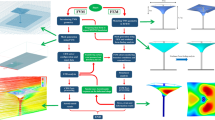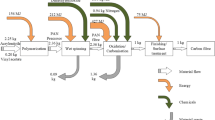Abstract
Current design concepts for transport aircraft aim at increasing the aircraft efficiency and performance by the introduction of advanced composite materials, such as carbon fibre reinforced plastics (CFRP). These novel transport aircraft designs may show dissimilar dynamic response behaviour due to differences in failure modes and energy absorption characteristics compared with the current transport aircraft designs made of aluminium alloys. For that reason, crash concepts are being developed to utilise the high specific energy absorption of composite materials for predefined load conditions. In the context of this paper, crash concepts for future CFRP transport aircraft were developed in which most of the kinetic energy is absorbed by tension energy absorbers integrated in the cabin and cargo floor, and by crushing energy absorbers integrated in the cabin floor support struts. The developed crash concepts define mainly parallel activation of different crash devices to achieve smooth energy absorption for different crash load scenarios. Crushing of the energy absorbers integrated in the cabin floor support struts is controlled by a novel structural design in this fuselage area. So far, this research is limited to conceptual studies performed on the basis of a generic CFRP fuselage design. Numerical simulations using the explicit finite-element (FE) code Abaqus/Explicit were performed to derive qualitative and quantitative results for an assessment of the crash concepts. A hybrid FE/macro model approach was used that combines typical FE discretisation with macro models for main failure representation. Two different crash kinematics were considered which distinguish between the failure patterns of the frame structure of the lower fuselage shell. The simulation results presented in this paper in terms of energy plots, passenger accelerations, and crash sequences identify favourable crash performance for a load scenario with fully loaded cabin and an impact velocity of 9.1 m/s (30 ft/s). Significant amount of kinetic energy could be absorbed by tension loads. Parallel activation of crash devices resulted in smooth crash kinematics with reduced trigger loads. By utilisation of the cabin floor support strut area as an energy absorption zone, sufficient energy absorption capacity could be provided even for load scenarios with increased impact energies. The results, presented in this paper, are the basis for further detailed research work on this tension crash concept.











Similar content being viewed by others
References
Federal Aviation Administration: Special conditions: Boeing model B787-8 airplane; Crashworthiness. US Federal register vol. 72, No. 111, Docket No. NM368 Special Conditions No. 25-07-05-SC (2007)
Federal Aviation Administration: Special conditions: Airbus model A350-900 airplane; Crashworthiness. US Federal register vol. 79, No. 143, Docket No. FAA-2013-0892 Special Conditions No. 25-537-SC (2014)
Boitnott, R.L., Fasanella, E.L., Calton, L.E., Carden, H.D.: Impact response of composite fuselage frames. SAE Technical Paper 871009 (1987)
Boitnott, R.L., Fasanella, E.L.: Impact evaluation of composite floor sections. SAE Technical Paper 891018 (1989)
Waimer, M., Kohlgrüber, D., Keck, R., Voggenreiter, H.: Contribution to an improved crash design for a composite transport aircraft fuselage—development of a kinematics model and an experimental component test setup. CEAS Aeronaut. J. 4, 265–275 (2013)
Woodson, M.B., Johnson, E.R., Haftka, R.T.: Optimal design of composite fuselage frames for crashworthiness. Int. J. Crashworthiness 1, 369–380 (1996)
Bergmann, T., Heimbs, S., Tremmel, G., Maier, M.: Investigation of a composite tensile energy absorption element under static and dynamic loading. In: 16th European Conference on Composite Materials (ECCM16). Seville, Spain (2014)
Feser, T., Waimer, M.: Numerical simulation of progressive bearing failure of bolted joints in CFRP aircraft structures. In: 1st International Conference on Impact Loading of Structures and Materials (ICILSM 2016). Turin, Italy (2016)
Heimbs, S., Bergmann, T.: Bearing mode absorber—on the energy absorption capability of pulling a bolt through a composite or sandwich plate. Procedia Eng. 88, 149–156 (2014)
Lützenburger, M., Johnson, A.F.: HeliSafe—helicopter occupant safety—development of a composite seat absorber element. DLR Technical Report D33-2a (2002)
Pein, M., Krause, D., Heimbs, S., Middendorf, P.: Innovative energy-absorbing concept for aircraft cabin interior. In: International Workshop on Aircraft System Technologies (AST 2007), pp. 375–384. Hamburg, Germany (2007)
Pein, M., Laukart, V., Feldmann, D.G., Krause, D.: Concepts for energy absorbing support structures and appropriate materials. In: 25th International Congress of the Aeronautical Sciences (ICAS 2006). Hamburg, Germany (2006)
Waimer, M., Kohlgrüber, D., Kraft, H., Hachenberg, D., Margull, L.: Connection arrangement and structure. Patent application EP 2 881 319 B1 (2015)
Desjardins, S.P.: The evolution of energy absorption systems for crashworthy helicopter seats. In: American Helicopter Society 59th Annual Forum. Phoenix, Arizona (2003)
Filsinger, J., Middendorf, P., Geßler, A.: Crash-Energieabsorber-Element, Anbindungselement mit einem solchen crash-energieabsorber-element, sowie Luftfahrzeug. Patent application DE 10 2006 056 440 A1 (2006)
Heimbs, S., Strobl, F., Middendorf, P., Guimard, J.M.: Composite crash absorber for aircraft fuselage applications. In: 11th International Conference on Structures under Shock and Impact (SUSI 2010), pp. 3–14. Tallinn, Estonia (2010)
Heimbs, S., Middendorf, P.: Design, analysis and testing of a composite crash absorber for aeronautic applications. In: 3rd ECCOMAS thematic conference on the mechanical response of composites, pp. 537–544. Hannover, Germany (2011)
Hull, D.: A unified approach to progressive crushing of fibre-reinforced composite tubes. Compos. Sci. Technol. 40, 377–421 (1991)
Johnson, A.F., David, M.: Failure mechanisms in energy-absorbing composite structures. Philos. Mag. 90, 4245–4261 (2010)
Milliere, J., Andissac, D., Raulot, C., Vincent, O.: Energy-absorbing structural element made of a composite material and aircraft fuselage having said absorber. Patent application US 2011/0042513 A1 (2011)
Waimer, M., Kohlgrüber, D., Hachenberg, D., Voggenreiter, H.: Experimental study of CFRP components subjected to dynamic crash loads. Compos. Struct. 105, 288–299 (2013)
Waimer, M.: Development of a kinematics model for the assessment of global crash scenarios of a composite transport aircraft fuselage., DLR-FB 2013-28 (2013)
Fasanella, E.L., Alfaro-Bou, E.: Vertical drop test of a transport fuselage section located aft of the wing. NASA-TM 89025 (1986)
Kumakura, I.: Vertical drop test of a transport fuselage section. SAE Technical Paper 2002-01-2997 (2002)
Kumakura, I., Minegishi, M., Iwasaki, K., Shoji, H., Miyaki, H., Yoshimoto, N., Sashikuma, H., Katayama, N., Isoe, A., Hayashi, T., Yamaoka, T., Akaso, T.: Summary of vertical drop tests of YS-11 transport fuselage sections. SAE Technical Paper 2003-01-3027 (2003)
Williams, M.S., Hayduk, R.J.: Vertical drop test of a transport fuselage section located forward of the wing. NASA TM85679 (1983)
Abramowitz, A., Smith, T.G., Vu, T.: Vertical drop test of a narrow-body transport fuselage section with a conformable auxiliary fuel tank onboard. DOT/FAA/AR-00/56 (2000)
Abramowitz, A., Smith, T.G., Vu, T., Zvanya, J.R.: Vertical drop test of a narrow-body transport fuselage section with overhead stowage bins. DOT/FAA/AR-01/100 (2002)
Johnson, D., Wilson, A.: Vertical drop test of a transport airframe section. DOT/FAA/CT-TN 86/34 (1986)
Logue, T.V., McGuire, R.J., Reinhardt, J.W., Vu, T.: Vertical drop test of a narrow-body fuselage section with overhead stowage bins and auxiliary fuel tank on board. DOT/FAA/CT-94/116 (1995)
Le Page, F., Carciente, R.: A320 fuselage section vertical drop test, part 2: test results. CEAT test report S95 5776/2, European community funded research project “Crashworthiness for commercial aircraft” (1995)
Pugliese, S.M.: B-707 fuselage drop test report. Arvin/Calspan Report No. 7252-1 prepared for FAA technical center Atlantic City (1984)
Beuck, G., Mueller, H.-J., Schliwa, R.: Multi-deck passenger aircraft having impact energy absorbing structures. Patent application US 5 542 626 (1996)
Bolukbasi, A.O., Baxter, T.R., Nguyen, T.A., Rassaian, M., Davis, K.R., Koch, W., Firth, L.C.: Energy absorbing structure for aircraft. Patent application GB 2 444 645 A (2008)
Delsart, D., Joly, D., Mahe, M., Winkelmuller, G.: Evaluation of finite element modelling methodologies for the design of crashworthy composite commercial aircraft fuselage. In: 24th International Congress of the Aeronautical Sciences (ICAS 2004). Yokohama, Japan (2004)
Waimer, M., Kohlgrüber, D., Hachenberg, D., Voggenreiter, H.: The kinematics model—a numerical method for the development of a crashworthy composite fuselage design of transport aircraft. In: The Sixth Triennial International Aircraft Fire and Cabin Safety Research Conference. Atlantic City, New Jersey, USA (2010)
Westphal, P., Dolzinski, W.-D., Roming, T., Schröer, T., Kohlgrüber, D., Lützenburger, M.: Strukturbauteil mit Spant- und Querträgerelement. Patent application DE 10 2007 030 026 A1 (2009)
Schatrow, P., Waimer, M.: Investigation of an alternative crash concept for composite transport aircraft using tension absorption. In: Seventh Triennial International Aircraft Fire and Cabin Safety Research Conference. Pennsylvania, Philadelphia, USA (2013)
Schatrow, P., Waimer, M.: Investigation of a crash concept for CFRP transport aircraft based on tension absorption. Int. J. Crashworthiness 19, 524–539 (2014)
Lützenburger, M.: KRASH related research projects at DLR. In: 6th International KRASH Users’ Seminar (IKUS6). Stuttgart, Germany (2009)
Desjardins, S.P., Zimmermann, R.E., Bolukbasi, A.O., Merritt, N.A.: Aircraft crash survival design guide—volume IV—aircraft seats, restraints, litters, and cockpit/cabin delethalization. USAAVSCOM TR 89-D-22D (1989)
Waimer, M.: Flugkörper.: Patent application DE 10 2009 020 891 B4 (2010)
Knops, G.L.W.M.: Supporting test work—aircraft seat component tests. Subtask 2.4 of the European community fundend Research Project Crashworthiness for Commercial Aircraft, TNO-report No.: 94.OR.BV.011.1/GKN (1994)
Eiband, A.M.: Human tolerance to rapidly applied accelerations: a summary of the literature. NASA MEMO 5-19-59E (1959)
Jackson, K.E., Fasanella, E.L., Boitnott, R.L., Lyle, K.H.: Full-scale crash test and finite element simulation of a composite prototype helicopter. NASA/TP-2003-212641 (2003)
Heimbs, S., Strobl, F., Middendorf, P.: Integration of a composite crash absorber in aircraft fuselage vertical struts. Int. J. Veh. Struct. Syst. 3, 87–95 (2011)
Jackson, A., Dutton, S., Gunnion, A.J., Kelly, D.: Investigation into laminate design of open carbon—fibre/epoxy sections by quasi—static and dynamic crushing. Compos. Struct. 93, 2646–2654 (2011)
Dassault Systèmes: Abaqus Documentation, version 6.13 (2013)
Acknowledgments
The research was conducted in collaboration with Airbus Operations GmbH. The authors wish to thank Dieter Hachenberg and Lars Margull (Airbus) for good support provided by technical discussions and information about structural designs.
Funding
The research leading to these results was accomplished in the framework of the 4th Aeronautical Research Programme of the German Federal Ministry for Economic Affairs and Energy (BMWi) (Grant No. 20W1105B) as part of the LuFo-IV project CREVAD (TENOR).
Author information
Authors and Affiliations
Corresponding author
Rights and permissions
About this article
Cite this article
Schatrow, P., Waimer, M. Crash concept for composite transport aircraft using mainly tensile and compressive absorption mechanisms. CEAS Aeronaut J 7, 471–482 (2016). https://doi.org/10.1007/s13272-016-0203-6
Received:
Revised:
Accepted:
Published:
Issue Date:
DOI: https://doi.org/10.1007/s13272-016-0203-6




